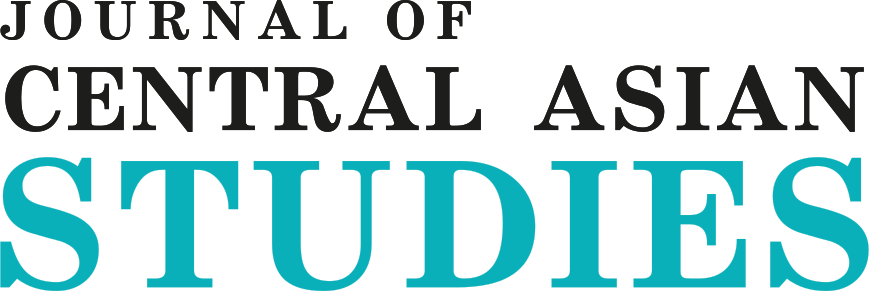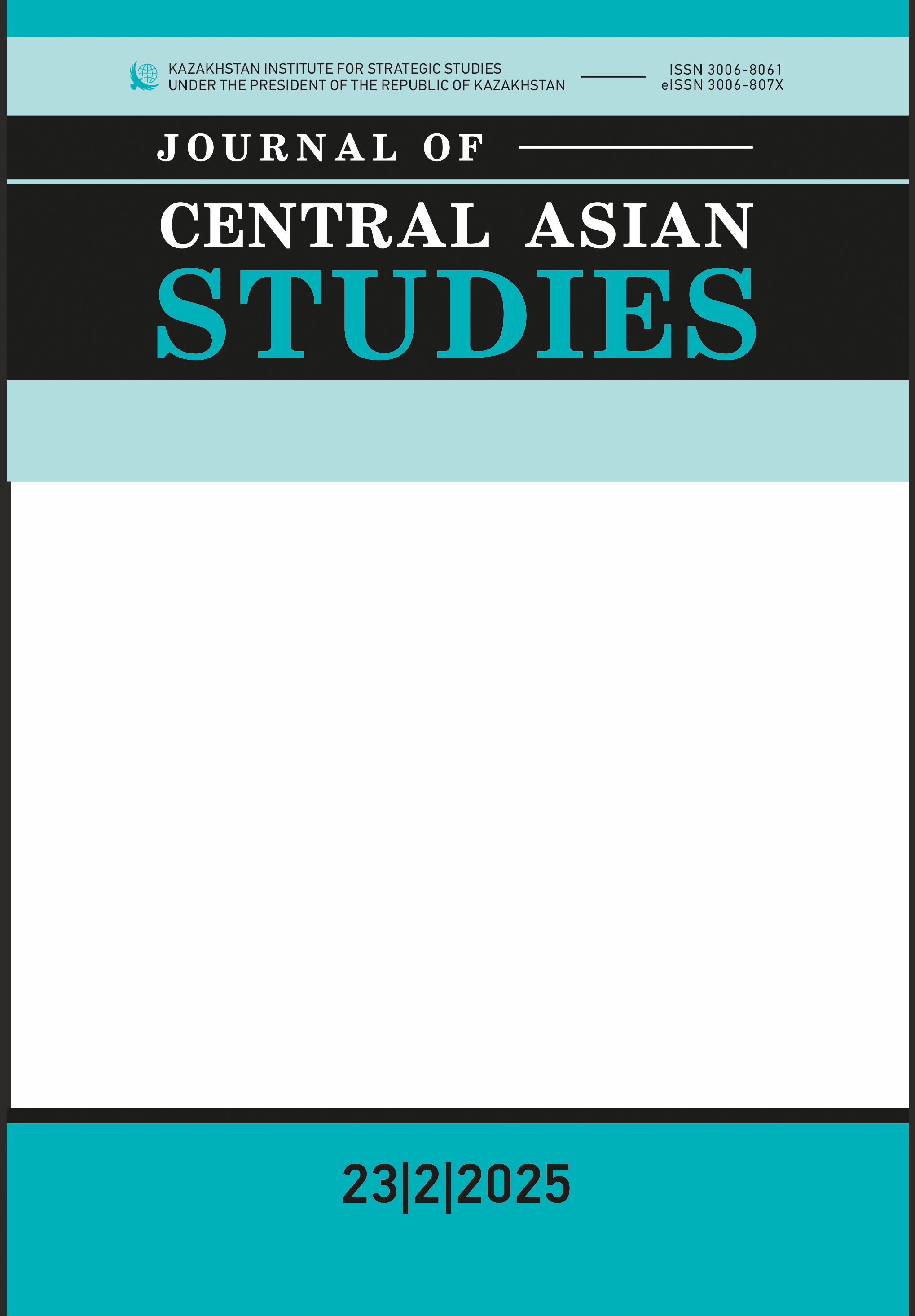Love Thy Neighbor? Central Asia in China’s New-Era Foreign Policy (2012–2024)
DOI:
https://doi.org/10.52536/3006-807X.2025-2.005Keywords:
BRI, Central Asia, China, foreign policy, neighborhoodAbstract
Central Asia is critical to China’s security and development. Although China repeatedly underlines the necessity and urgency of establishing a good neighborhood with Central Asian countries, it has not released any strategies and specific policies, at least not explicitly. This article examines Central Asia’s sui generis in China’s new-era neighborhood diplomacy from 2012 to 2024. It contends that China’s foreign policies have evolved so subtly that Central Asia has been prioritized comparatively. With the aim of building a good neighborly relationship in mind, China has stepped up its engagement in Central Asia under the aegis of the Belt and Road Initiative, culminating in the China-Central Asia Summit in 2023.
References
Aboulafia, M. (2010). Transcendence: On Self-Determination and Cosmopolitanism. Stanford, California: Stanford University Press.
Adler, E. (2010). Damned If You Do, Damned If You Don’t: Performative Power and the Strategy of Conventional and Nuclear Defusing. Security Studies, 19(2), 199–229.
Blank, S. (2012). Wither the New Great Game in Central Asia. Journal of Eurasian Studies, 3, 147–160.
Chang, K. S. (2012). Predicaments of Neoliberalism in the Post-Developmental Liberal Context. In C. Kyung-Sup, B. Fine, & L. Weiss (Eds.), Developmental Politics in Transition: The Neoliberal Era and Beyond (pp. 70–91). Basingstoke: Palgrave Macmillan.
China Daily. (2013, October 26). Xi Jinping: China to further Friendly Relations with Neighboring Countries. https://www.chinadaily.com.cn/china/2013-10/26/content_17060884.htm.
Chinese Ministry of Foreign Affairs. (2023). President Xi Jinping and the Presidents of the Five Central Asian Countries Jointly Meet the Press. https://www.mfa.gov.cn/eng/wjb/zzjg_663340/yzs_663350/xwlb_ 663352/202305/t20230519_11080118.html.
Choi, Y. J. (2009). South Korea’s Regional Strategy and Middle Power Activism. The Journal of East Asian Affairs, 23(1), 47–67.
Collier, P. (2007). The Bottom Billion: Why the Poorest Countries are Failing and What Can Be Done about It. New York: Oxford University Press.
Cooper, A. F., & Schulz, C.A. (2023). How Secondary States Can Take Advantage of Networks in World Politics: The Case of Bridges and Hubs. Globalizations. https://doi.org/10.1080/14747731.2023.2190701.
Dai, B. (2016). Strategic Dialogues: Dai Bingguo Memoirs. Beijing: People’s Press.
Fingar, T. (ed.) (2016). The New Great Game: China and South and Central Asia in the Era of Reform. Stanford: Stanford University Press.
Freeman, C.P. (2018). New Strategies for an Old Rivalry? China–Russia Relations in Central Asia after the Energy Boom. The Pacific Review, 31(5), 635–654.
Fu, Y. (2018). Seeing the World 1. Beijing: CITIC Press.
Gardner, H. (2017). Xi Jinping: Time for “New Era” China to “Take Center Stage in the World”. USA Today. https://www.usatoday.com/story/news/world/2017/10/18/xi-jinping-time-new-era-china-take-center-stage-world/774958001/.
Gautam, S. (2023). Xi’an Declaration: A Boon for Cooperation. China Daily. https://global.chinadaily.com.cn/a/202305/22/WS646b36c0a310b6054fad4707.html.
Hardt, M., & Negri A. (2009). Commonwealth. Cambridge, Massachusetts: The Belknap Press of Harvard University Press.
Hou, P. (2023). Bridge or Base? Chinese Perceptions of Central Asia under Europeanisation. Central Asian Survey, 42(3), 577–596.
Horowitz, D.L. (1985). Ethnic Groups in Conflict. Berkeley: University of California Press.
Howorth, J. (2016). EU Global Strategy in A Changing World: Brussels’ Approach to the Emerging Powers. Contemporary Security Policy, 37(3), 389–401.
Lampton, D.M. (2005). China’s Rise in Asia Need Not Be at America’s Expense. In D. Shambaugh (Ed.), Power Shift: China and Asia’s New Dynamics (pp. 306–326). Berkeley: University of California Press.
Liao, J.X. (2021). China’s Energy Diplomacy Towards Central Asia and the Implications on Its “Belt and Road Initiative”. The Pacific Review, 34(3), 490–522.
Oppenheim, M.D. (2007). Loving the Neighbor: Some Reflections on Narcissism. Modern Judaism, 27(1), 47–71.
Pan, G. (2013). The Spirit of the Silk Road: The SCO and China’s Relations with Central Asia. In M. Fredholm (Ed.), The Shanghai Cooperation Organization and Eurasian Geopolitics: New Directions, Perspectives, and Challenges (pp. 20–28). Copenhagen: NIAS Press.
Pan, Z. (2002). “Central Asia”: Reflections on Geopolitics, Economic and Culture. In W. Fuhuan & G. Zhengli (Eds.) A Collection of Research Papers on Xinjiang and Central Asia Affairs (pp. 52–65). Urumqi: Xinjiang University Press.
People’s Daily. (2024). Advocating the Five Principles of Peaceful Existence and Advancing the Construction of a New Type of International Relations. http://paper.people.com.cn/rmrbwap/html/2024-06/28/nw.D110000renmrb_20240628_2-02.htm.
Qin, Y. (2018). A Relational Theory of World Politics. New York: Cambridge University Press.
Qiu, H. (2015). China’s Neighhorhood Diplomacy and Sino-U.S. Relations in the Transition of International Order. Beijing: People’s Press.
Reinhard, K. (2005). Toward a Political Theology of the Neighbor. In S. Žižek, E. L. Santner & K. Reinhard (Eds.), The Neighbor: Three Inquiries in Political Theology (pp.11–75). Chicago and London: The University of Chicago Press.
Shi, Y. et al. (2019). China’s Peripheral Neighboring in Modern Time. Beijing: Zhonghua Book Company.
Shin, G.W., & Lee, S.H. (2022). Op-Ed: In China, Xi Jinping Is Getting an Unprecedented Third Term. What Should the World Expect? Los Angeles Times. https://www.latimes.com/opinion/story/2022-10-20/china-government-president-xi-jinping.
Sun, L. (2005). Modernization and Social Transformation. Beijing: Peking University Press.
Summers, T. (2016). China’s “New Silk Roads”: Sub-National Regions and Networks of Global Political Economy. Third World Quarterly, 37(9), 1628–1643.
Summers, T. (2020). Structural Power and the Financing of the Belt and Road Initiative. Eurasian Geography and Economics, 61(2), 146–151.
Tsygankov, A.P. (2005). Vladimir Putin’s Vision of Russia as a Normal Great Power. Post-Soviet Affairs, 21(2), 132–158.
Walzer, M. (2011). The Rights of Political Communities. In M. Frost (Ed.), Volume I. The Moral Standing of States and the Society of States (pp. 53–57). London: SAGE.
Wu, L. (2016). The Dynamics and Mechanism of China’s Regional Policy after the Cold War. Beijing: Zhonghua Book Company.
Xi, J. (2014a). Build A Bridge of Friendship and Cooperation across the Eurasian Continent (April 1, 2014). In Xi Jinping: The Governance of China, Vol. I (pp. 297–305). Beijing: Foreign Languages Press.
Xi, J. (2014b). Diplomacy with Neighboring Countries Characterized by Friendship, Sincerity, Reciprocity and Inclusiveness (October 24, 2013). In Xi Jinping: The Governance of China, Vol. I (pp. 325–329). Beijing: Foreign Languages Press.
Xi, J. (2014c). New approach for Asian security cooperation (May 21, 2014). In Xi Jinping: The Governance of China, Vol. I (pp. 389–396). Beijing: Foreign Languages Press.
Xi, J. (2014d). Work Together to Build the Silk Road Economic Belt (September 7, 2013). In Xi Jinping: The Governance of China, Vol. I (pp. 315–319). Beijing: Foreign Languages Press.
Xi, J. (2015). Forging a Strong Partnership to Enhance Prosperity of Asia. Singapore: Yusof Ishak Institute.
Xi, J. (2017a). Full Text of Xi Jinping’s Report at 19th CPC National Congress. China Daily. https://www.chinadaily.com.cn/china/19thcpcnationalcongress/2017-11/04/content_34115212.htm.
Xi, J. (2017b). The Belt and Road Initiative and Connectivity are Mutually Reinforcing (November 8, 2014). In Xi Jinping: The Governance of China, Vol. II (pp. 543–545). Beijing: Foreign Languages Press.
Xi, J. (2019a). On Building a Human Community with a Shared Future. Beijing: Central Compilation & Translation Press.
Xi, J. (2019b). Create an Asian Community of Shared Future through Mutual Learning (May 15, 2019). In Xi Jinping: The Governance of China, Vol. III (pp. 540–547). Beijing: Foreign Languages Press.
Xi, J. (2022). Hold High the Great Banner of Socialism with Chinese Characteristics and Strive in Unity to Build a Modern Socialist Country in All Respects–Report to the 20th National Congress of the Communist Party of China, October 16, 2022. https://english.www.gov.cn/atts/stream/files/6357d404c6d028997c37ca9b.
Xinhua News Agency. (2022, September 18). Managing Well Development and Security. http://www.news.cn/politics/2022-09/18/c_1129012306.htm (accessed December 11, 2024).
Yan, X. (2015). Holistic Neighbourhood Outweighs the US. Global Times. http://www.xinhuanet.com/politics/2015-01/15/c_127388725.htm.
Zhang, J., & Saxer, M. (2017). Introduction: Neighbouring in the Borderworlds along China’s Frontiers. In M. Saxer & Z. Juan (Eds.), The Art of Neighbouring. Making Relations Across China’s Borders (pp. 11–29). Amsterdam: Amsterdam University Press.
Zhang, Y. (2016). China and Its Neighbourhood: Transformation, Challenges and Grand Strategy. International Affairs, 92(4), 835–848.
Zhao, T. (2006). Rethinking Empire from a Chinese Concept “All-Under-Heaven” (Tian-xia, 天下). Social Identities, 12(1), 29–41.
Zhao, T. (2022). The Myth or Tragedy of Artificial Intelligence. Beijing. The Commercial Press.
Zheng, Y. (2019). Discovering Chinese Nationalism in China, Modernization, Identity, and International Relations (Chinese edition). Beijing: The Oriental Press.
Zheng, Y. (2021). The China Model: Experience and Challenges (newly revised edition). Beijing: CITIC Press.
Downloads
Published
Issue
Section
License
Copyright (c) 2025 Hou P.

This work is licensed under a Creative Commons Attribution 4.0 International License.











 Open content is licensed under the CC-BY
Open content is licensed under the CC-BY 